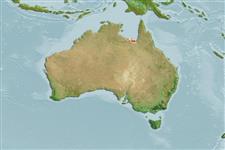Common names from other countries
>
Ovalentaria/misc (Various families in series Ovalentaria) >
Pseudochromidae (Dottybacks) > Congrogadinae
Etymology: Congrogadus: Latin, conger = conger + Latin, gadus = a fish, perhaps cod (Ref. 45335); amplimaculatus: Name from the Latin 'amplus' (= large in size) and 'maculatus' (= spotted or full of spots) referring to the large number of large pale spots on the body; should be treated as a noun in apposition (Ref. 675).
More on author: Winterbottom.
Environment: milieu / climate zone / depth range / distribution range
Ecologia
marinhas demersal. Tropical; 16°S - 18°S
Western Pacific: presently known only from the southern portion of the Gulf of Carpentaria.
Tamanho / Peso / Idade
Maturity: Lm ? range ? - ? cm
Max length : 12.9 cm SL macho/indeterminado; (Ref. 675)
Espinhos dorsais (total): 0; Raios dorsais moles (total): 62-64; Espinhos anais 0; Raios anais moles: 52 - 54; Vértebras: 66 - 69. Opercle with a dark ocellated spot. Gill membranes fused to the isthmus. Posterior otic sensory canal pore absent. Preopercular canal usually with 7 pores. Large spots arranged in three rows where dorsalmost and ventralmost rows extending distally on bases of dorsal and anal fin bases.
Feeds mainly on crustaceans. Collected from areas with substrates of sponges, sand, a little mud and few large shell fragments. Eggs with cruciform hooks on the surface.
Life cycle and mating behavior
Maturidade | Reprodução | Desova | Ovos | Fecundidade | Larvas
Winterbottom, R., 1985. Revision and vicariance biogeography of the subfamily Congrogadidae (Pisces: Perciformes: Pseudochromidae). Indo-Pac. Fish. (9):34 p. (Ref. 531)
Categoria na Lista Vermelha da IUCN (Ref. 130435)
CITES (Ref. 128078)
Not Evaluated
Ameaça para o homem
Harmless
Utilização humana
Mais informação
Nomes comunsSinónimosMetabolismoPredadoresEcotoxicologiaReproduçãoMaturidadeDesovaFecundidadeOvosDesenvolvimento dos ovos
Idade/TamanhoCrescimentoComprimento-pesoComprimento-comprimentoFrequência de comprimentoMorfometriaMorfologiaLarvasDinâmica larvarRecrutamentoAbundância
ReferênciasAquaculturaPerfil para aquaculturaEstirpesGenéticaElectrophoresesHereditariedadeDoençasProcessamentoMass conversion
ColaboradoresFotografiasStamps, Coins Misc.SonsCiguateraVelocidadeTipo de nataçãoÁrea branquialOutras referênciasCérebrosVisão
Ferramentas
Relatórios especiais
Descarregue XML
Fontes da internet
Estimates based on models
Phylogenetic diversity index (Ref.
82804): PD
50 = 0.5156 [Uniqueness, from 0.5 = low to 2.0 = high].
Bayesian length-weight: a=0.00102 (0.00046 - 0.00225), b=3.06 (2.88 - 3.24), in cm Total Length, based on all LWR estimates for this body shape (Ref.
93245).
Nível Trófico (Ref.
69278): 3.5 ±0.50 se; based on food items.
Resiliência (Ref.
120179): Elevada, tempo mínimo de duplicação da população menor que 15 meses (Preliminary K or Fecundity.).
Fishing Vulnerability (Ref.
59153): Low vulnerability (10 of 100).
